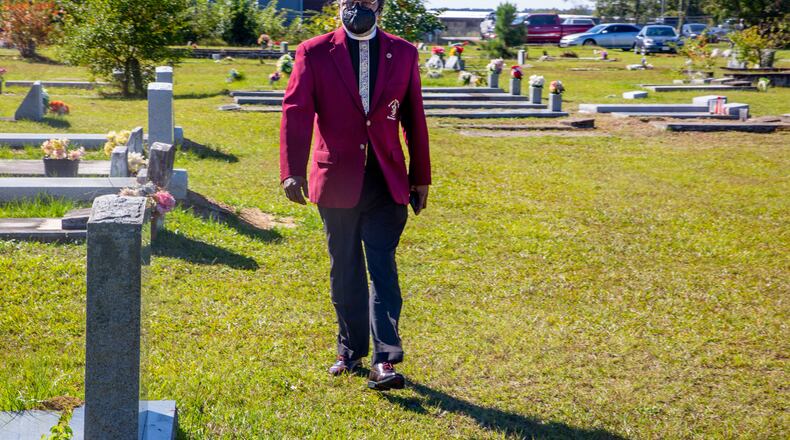The health department crew set up shop in a building near the Georgia National Fair’s north gate, not far from the stage where a juggler and a hypnotist would later perform, a short walk to the midway where throngs of people lined up for the Grand Carousel, the Dizzy Dragon and other carnival rides.
All around the clinicians, a steady stream of people flowed by. But few expressed interest in what they were hawking: COVID-19 shots, free for the taking.
It was a fine idea. The North Central Health District employees wanted to make the vaccinations accessible to more of the state’s residents, especially those who live in the rural areas that surround the Georgia National Fairgrounds and Agricenter in Perry. But — despite the workers approaching fair attendees, answering their questions about the vaccines, sharing data on the shots’ effectiveness — the results were disappointing.
Close to 500,000 people attended the fair earlier this month. And, over seven days, the health department vaccinated a total of 29 of them.
“The number of people who can be convinced to get the shot is getting smaller and smaller,” Michael Hokanson, public information officer and risk communicator for the Georgia Department of Public Health’s 13-county district in the middle of the state.
But public health experts say it’s imperative that they keep trying.
Since August, as the pandemic’s delta variant caused a surge in cases, rural Georgians have been dying of COVID-19 at more than twice the rate of their urban counterparts, according to an Atlanta Journal-Constitution analysis of state health data.
COVID-19 has claimed more than 19,000 lives in urban counties like Fulton, DeKalb, Muscogee and Bibb, the type of counties where 80% of the state’s population resides. But in the quiet small towns that make up much of the state, the per-capita toll is even greater, especially during this latest surge.
In Pierce County, with a population of 19,000 located a dozen miles northeast of Waycross, a resident was 10 times more likely to die of COVID-19 than someone in 1 million-strong Fulton County, home of the state Capitol, the analysis found.
A big part of the reason for that, medical experts say, is the low vaccination rates in rural Georgia. Only 38% of residents who live in those areas are fully vaccinated compared to 45% in urban counties, according to the AJC’s analysis. But, experts add, the low vaccination rates don’t fully capture why mortality rates are so much higher in rural areas than elsewhere.
Public health experts say rural residents started out more vulnerable to the coronavirus because of a lack of access to medical care, which, in turn, means they are more likely to have untreated or uncontrolled chronic health conditions.
“In general, rural people are older, sicker and poorer, all of which are characteristics associated with more vulnerability to the virus,” said Keith Mueller, director of the Iowa-based Rural Policy Research Institute.
While vaccination won’t stop all infections, breakthrough cases in inoculated patients are usually much less serious, medical experts say. Of the Georgians who have died of COVID-19 since vaccines became available in January, 5% were fully vaccinated.
Georgia’s health care community needs to do more of everything now to save lives, experts say. Public health officials need to be more aggressive and personal in their community outreach. They need adequate staff to do that. Doctors need to have more one-on-one conversations with their patients to encourage vaccinations. The state needs to do more to improve health resources in rural areas, so more people know a trusted doctor or nurse when the next pandemic comes around.
Raising the vaccination rate has proved to be difficult, they say. But it’s not impossible.
Push back
At the beginning of the year, with demand for newly available COVID-19 vaccines high and space in his 100-year-old drugstore tight, Crawford County pharmacist Josh Patterson set up a makeshift vaccination clinic in a restaurant across the street.
The spacious eatery was closed on Tuesdays, which made it the perfect location.
For weeks, residents lined up to take the shots. But, as pecan trees woke from their winter dormancy and peach trees started to blossom, the number of people seeking vaccinations in the county of 12,500 dwindled. Patterson shut down his off-site operation.
Now, only the occasional person comes into Roberta Drugs, the only pharmacy, looking to get vaccinated.
Credit: Steve Schaefer
Credit: Steve Schaefer
The way Patterson sees it, most of the locals who want to be vaccinated are vaccinated. And, unless their circumstances change or the pandemic gets even worse, he can’t imagine demand growing much in the town located about 25 miles west of Macon. Government recommendations aren’t going to make a difference, he said. Neither will this statistic: Crawford County residents are four times as likely to die of COVID-19 than people who live in urban counties.
Many people in Crawford County and other parts of the state aren’t convinced that public health authorities are right about the vaccines, Patterson said. Some residents are wary of the long- and short-term health ramifications of taking the injections, suspect of the changing advice from the experts, and feel like they are being strong-armed.
“No one here wants to be told what to do by the government,” Patterson said. “Even though I believe with all my heart the vaccine is safe and effective, I know when you have something pushed by the government, that makes people more hesitant, and they are more likely to push back.”
In many of the state’s rural areas, people tend to be politically conservative and are among the most fervently opposed to getting vaccinated. More rural residents view getting vaccinated as a personal choice rather than social responsibility, according to the Kaiser Family Foundation. They also are more likely to believe the news on the virus has been generally exaggerated, according to the foundation.
Kerry Dunaway, who was once the county’s sheriff and now works as a farmer, has survived COVID-19 twice. He sees no reason for getting vaccinated now, or ever.
“The vaccine won’t prevent me from getting COVID,” said Dunaway, who is in his early 60s. “And I survived it twice. I just don’t see the point.”
The vaccination rate differences between rural and urban counties can be stark. In Crawford County, only 36% of residents are vaccinated. In metro Atlanta’s Fayette, 56% of residents are fully vaccinated.
Credit: Steve Schaefer
Credit: Steve Schaefer
Charlie A. Hicks II said he sees the results of that. He said he’s working 18-hour days at Hicks & Son Funeral Home, which has four locations including one in Roberta. The hours, days, deaths have started to run together for him.
He’s buried people in their 20s, 30s, 40s — people who, if it weren’t for COVID-19, had several decades, their whole lives ahead of them, he said.
“Essentially, people are setting up their camp, figuring out where they are in that decision, and that camp is slowly becoming their home – not something you can easily pack up and move to the other side,” said Hokanson, from the North Central Health District.
But it’s not just simply a matter of attitude toward the vaccines. Easy access is also part of the challenge.
Rolling ‘snake eyes’
Far more than in urban areas, rural counties lack doctors; people lack insurance; and hospitals have gone bankrupt and closed. Distances to health care sites are long, and not everyone has cars.
Brian Castrucci, an epidemiologist who worked for the Georgia Department of Public Health before becoming head of a public health charity in Maryland, said the problem should be no surprise.
“We ignored these trends and gambled with people’s lives; we finally rolled snake eyes,” Castrucci said.
Patterson’s Crawford County only has one medical doctor. It could be worse: Nine Georgia counties have no doctor at all.
In Roberta, residents are more than 15 miles away from a hospital. But there are several rural swaths in the state where residents live more than 30 miles, even 50 miles or more, from the nearest hospital. People tend to tough out their illnesses at home. Many rural counties have volunteer emergency medical service or sometimes none at all.
Near Waycross, seven neighboring counties have no internal medicine physician, even part-time, according to a 2017 report by the Georgia Board of Health Care Work Force. Five had no pediatrician. And that’s before a health care worker shortage swept across the nation in the pandemic.
Where there is no doctor, county boards of health are supposed to fill in for some functions, working with the state Department of Public Health. But the agency is stretched. DPH currently has 268 unfilled open positions, many of them at county health offices in rural parts of Georgia. The pay the state offers often cannot compete with private health sites.
“The number of people who can be convinced to get the shot is getting smaller and smaller."
In the immediate short term, Castrucci and others say health officials should mobilize pop-up vaccination clinics and make concerted efforts to reach those who may still be on the fence about the vaccine. Community leaders need to be engaged, he said, so that resources and information can be tailored for specific areas.
It’s time for a long-term strategy and investment in health care in rural communities, not a flash-in-the-pan reaction, said Castrucci.
“COVID occurred at a time when our nation’s (public health) foundation was cracked,” he said. “And we knew all of these things and didn’t do anything until we went off a cliff. You don’t solve problems that way.”
Wins to be had
In the southwestern end of the state in Clay County, Dr. Karen Kinsell still believes there are wins to be had in getting people vaccinated. But it is no easy task.
It starts, she said, with acknowledging barriers to vaccination that are particular to rural areas.
Because of the storage requirements for the Pfizer vaccines, it’s not available in Kinsell’s area, and that’s the only shot authorized for children ages 12 to 17. Vaccines don’t come in single-dose vials, which means if a lone person in a low-demand area wants a shot, doctors must decide whether to use a bottle and let other doses go to waste if no one else shows up. She usually says yes. Not everyone does though.
Few residents have a vaccination site around the corner. And almost no one can get the shot on a whim, she said. Appointments are hurdles. Distance matters, she said. From Clay County, the closest pharmacy, CVS, is 20 miles away, she said.
“Do people travel 20 Miles? Yeah,” Kinsell said. “But you add that on top of vaccine hesitancy — and if someone’s really motivated, they’re going to make it. If they’re not motivated, that’s pretty much a deal killer.”
Early in the year when demand was high, the county health department held several vaccination events, public health workers said. Starting in May as demand fell, it’s been up to people to make appointments. The Clay County health building is currently closed because of structural problems, so those people are advised to go to a nearby county, perhaps Randolph.
But waiting for people to come asking for vaccines doesn’t work anymore, Kinsell said. She thinks doctors and other health workers have to be more proactive.
Every time she’s in contact with a patient for any reason, on the phone or in person, she brings it up. She makes jokes. She tries conversation.
“My basic philosophy is, keep talking until they either leave the room or hang up, or agree,” she said. It’s slow, she said, but in repeated contacts, she continues to change some minds.
Credit: Steve Schaefer
Credit: Steve Schaefer
Persuasion works, Castrucci said, but only with trusted members of the communities, such as local leaders, physicians and pastors — people who already have relationships and friendships with community members, those who share similar values, and whose children go to school together.
“We need an all-hands-on-deck approach,” said Dr. Felipe Lobelo an epidemiologist and associate professor at Emory University School of Public Health.
Chris Rustin, with the Georgia Health Department of Public Health, agrees that people can still be persuaded to get the shot.
Rustin, acting deputy commissioner and incident manager of COVID-19 response, said more than 100 mobile vaccine clinics were set up last week across the state – everywhere from barbershops and farmers markets to festivals.
“Sometimes, we may have five or 10 people,” he said.“It will take time to move the needle.”
Cynthia Davis of Roberta is one of those people who reconsidered. The 68-year-old said she doesn’t leave her house much and isn’t around crowds. So, she didn’t see the need for a vaccine. But then several family members recently got sick with COVID-19, including one who needed to be hospitalized for more than a week.
“That did it, that changed my mind,” she said.
The Latest
Featured








